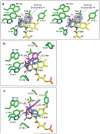Structure-Based Insight into the Asymmetric Bioreduction of the C=C Double Bond of alpha,beta-Unsaturated Nitroalkenes by Pentaerythritol Tetranitrate Reductase
- PMID: 20396603
- PMCID: PMC2854801
- DOI: 10.1002/adsc.200800561
Structure-Based Insight into the Asymmetric Bioreduction of the C=C Double Bond of alpha,beta-Unsaturated Nitroalkenes by Pentaerythritol Tetranitrate Reductase
Abstract
Biocatalytic reduction of alpha- or beta-alkyl-beta-arylnitroalkenes provides a convenient and efficient method to prepare chiral substituted nitroalkanes. Pentaerythritol tetranitrate reductase (PETN reductase) from Enterobacter cloacae st. PB2 catalyses the reduction of nitroolefins such as 1-nitrocyclohexene (1) with steady state and rapid reaction kinetics comparable to other old yellow enzyme homologues. Furthermore, it reduces 2-aryl-1-nitropropenes (4a-d) to their equivalent (S)-nitropropanes 9a-d. The enzyme shows a preference for the (Z)-isomer of substrates 4a-d, providing almost pure enantiomeric products 9a-d (ees up to > 99%) in quantitative yield, whereas the respective (E)-isomers are reduced with lower enantioselectivity (63-89% ee) and lower product yields. 1-Aryl-2-nitropropenes (5a, b) are also reduced efficiently, but the products (R)-10 have lower optical purities. The structure of the enzyme complex with 1-nitrocyclohexene (1) was determined by X-ray crystallography, revealing two substrate-binding modes, with only one compatible with hydride transfer. Models of nitropropenes 4 and 5 in the active site of PETN reductase predicted that the enantioselectivity of the reaction was dependent on the orientation of binding of the (E)- and (Z)-substrates. This work provides a structural basis for understanding the mechanism of asymmetric bioreduction of nitroalkenes by PETN reductase.
Figures







Similar articles
-
Asymmetric Reduction of Activated Alkenes by Pentaerythritol Tetranitrate Reductase: Specificity and Control of Stereochemical Outcome by Reaction Optimisation.Adv Synth Catal. 2009 Nov;351(17):2976-2990. doi: 10.1002/adsc.200900603. Adv Synth Catal. 2009. PMID: 20396613 Free PMC article.
-
Proton transfer in the oxidative half-reaction of pentaerythritol tetranitrate reductase. Structure of the reduced enzyme-progesterone complex and the roles of residues Tyr186, His181, His184.FEBS J. 2005 Sep;272(18):4660-71. doi: 10.1111/j.1742-4658.2005.04875.x. FEBS J. 2005. PMID: 16156787
-
Kinetic and structural basis of reactivity of pentaerythritol tetranitrate reductase with NADPH, 2-cyclohexenone, nitroesters, and nitroaromatic explosives.J Biol Chem. 2002 Jun 14;277(24):21906-12. doi: 10.1074/jbc.M200637200. Epub 2002 Mar 28. J Biol Chem. 2002. PMID: 11923299
-
Atomic resolution structures and solution behavior of enzyme-substrate complexes of Enterobacter cloacae PB2 pentaerythritol tetranitrate reductase. Multiple conformational states and implications for the mechanism of nitroaromatic explosive degradation.J Biol Chem. 2004 Jul 16;279(29):30563-72. doi: 10.1074/jbc.M403541200. Epub 2004 May 5. J Biol Chem. 2004. PMID: 15128738
-
Aerobic degradation of 2,4,6-trinitrotoluene by Enterobacter cloacae PB2 and by pentaerythritol tetranitrate reductase.Appl Environ Microbiol. 1998 Aug;64(8):2864-8. doi: 10.1128/AEM.64.8.2864-2868.1998. Appl Environ Microbiol. 1998. PMID: 9687442 Free PMC article.
Cited by
-
Light-driven biocatalytic reduction of α,β-unsaturated compounds by ene reductases employing transition metal complexes as photosensitizers.Catal Sci Technol. 2016 Jan 7;6(1):169-177. doi: 10.1039/c5cy01642h. Epub 2015 Oct 26. Catal Sci Technol. 2016. PMID: 27019691 Free PMC article.
-
Tailored photoenzymatic systems for selective reduction of aliphatic and aromatic nitro compounds fueled by light.Nat Commun. 2023 Sep 6;14(1):5442. doi: 10.1038/s41467-023-41194-w. Nat Commun. 2023. PMID: 37673927 Free PMC article.
-
The structure of glycerol trinitrate reductase NerA from Agrobacterium radiobacter reveals the molecular reason for nitro- and ene-reductase activity in OYE homologues.Chembiochem. 2013 May 10;14(7):836-45. doi: 10.1002/cbic.201300136. Epub 2013 Apr 18. Chembiochem. 2013. PMID: 23606302 Free PMC article.
-
Recombinant expression and characterisation of the oxygen-sensitive 2-enoate reductase from Clostridium sporogenes.Microbiology (Reading). 2018 Feb;164(2):122-132. doi: 10.1099/mic.0.000568. Epub 2017 Nov 7. Microbiology (Reading). 2018. PMID: 29111967 Free PMC article.
-
Asymmetric Reduction of Activated Alkenes by Pentaerythritol Tetranitrate Reductase: Specificity and Control of Stereochemical Outcome by Reaction Optimisation.Adv Synth Catal. 2009 Nov;351(17):2976-2990. doi: 10.1002/adsc.200900603. Adv Synth Catal. 2009. PMID: 20396613 Free PMC article.
References
Grants and funding
LinkOut - more resources
Full Text Sources
